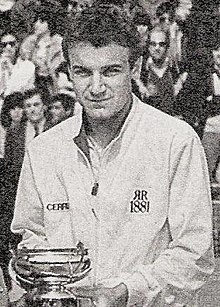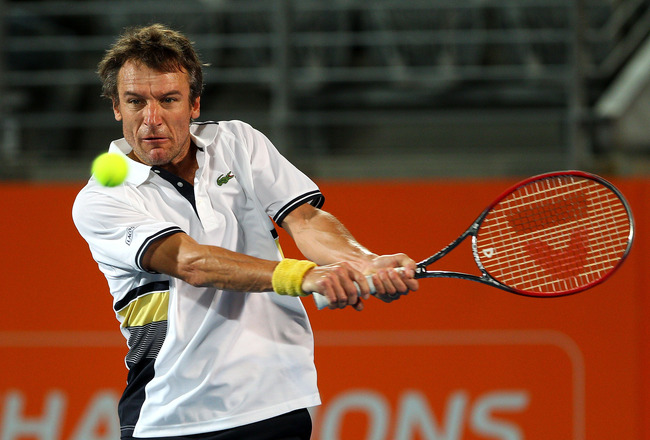Mats Wilander Biography
A former No.-1 ranked male tennis player, Sweden's Mats Wilander won seven Grand Slam singles titles and one Grand Slam doubles title during his 16-year career.
He won 33 singles titles in all and was inducted into the International Tennis Hall of Fame in 2002. Wilander turned pro the same year that Swedish legend Bjorn Borg retired. He played against his idol in 1981 in Geneva, losing 6-1, 6-1.
In 1982, he started the year by reaching the finals at Brussels and the semifinals at Rome, then stunned the tennis world by winning the French Open title, upsetting No. 2 Ivan Lendl in the fourth round, No. 5 Vitas Gerulaitis in the quarterfinals, No. 4 Jose Luis Clerc in the semifinals and No. 3 Guillermo Vilas in the final, which took nearly five hours. At the time, it made him the youngest man (17 years, 9 months) to ever win any Grand Slam event. He went on to win at Bastad and Geneva, and reach the fourth rounds of Wimbledon and the US Open.
Wilander finished seventh again in 1983, getting hot at mid-season with consecutive wins at Monte Carlo, Lisbon and Aix-En-Provence. He reached the final again at Roland Garros, but lost to He reached the final again at Roland Garros, but lost to Yannick Noah in straight sets. He won at Basatad again, and added the Cincinnati before reaching the quarterfinals of the US Open. Wilander ended the year white-hot, taking the titles at Geneva, Barcelona and Stockholm. He capped his season with his second Grand Slam, winning the Australian Open by besting John McEnroe in the semifinals and Lendl in a straight-set final.
The following season, Wilander added his second Australian Open title and made his year-end debut in the Top 5 at No. 4. He did not play many tournaments early, with his debut on tour not coming until March 5. He fell in the semifinals of the French Open to Lendl in straight sets, and tumbled early at Wimbledon, upset in the second round by Pat Cash. Wilander did not win his first title of the year until repeating at Cincinnati, but picked up steam at year's end again. He won Barcelona, reached the finals of Stockholm, then took another crown in Australia, defeating American Kevin Curren.
Wilander made it four majors in four years in 1985, claiming his second French Open title while ascending to No. 3 in the world. He had yet to win a title in 1985 when the action started at Roland Garros, but he was brilliant on clay, defeating No. 1 McEnroe in straight sets in the semifinals, then rallying past No. 2 Lendl in four sets for the crown. He won two more titles and reached five other finals the rest of the year, missing out on a third straight Australian Open crown when he fell in the finals to countryman Stefan Edberg.
Wilander did not win a singles Slam in 1986, but still finished third overall and added his only doubles Slam, pairing with countryman Joakim Nystrom to win Wimbledon. The pair also reached the doubles final at the US Open. As a singles player, Wilander won two titles and reached three other finals.
His Slam slump continued in 1987, but he finished third overall for a third straight season. He won at Brussels, Monte Carlo, Rome, Boston and Indianapolis. He also reached the finals at the French Open, losing to Lendl in the final after defeating No. 2 Boris Becker in the semifinals, and again at the US Open, defeating Edberg in the semifinals but again falling short against Lendl.
After two years without a singles Slam, Wilander reached the apex of his career in 1998, winning three of the four majors and finishing the year ranked No. 1. He began the season by taking home his third Australian Open title, defeating Edberg in the semifinals and local favorite Cash for the title. He won again at Key Biscayne, then took his second French Open title, defeating three straight double-digit seeds in the final three rounds. His quest for three straight Slams was brought down by Miloslav Mecir, who knocked him off in the quarterfinals at Wimbledon in straight sets. Wilander rebounded to win his favorite event -- Cincinnati -- and carried the momentum into the US Open where he defeated Lendl in five sets in the final to take a third major and take over the No. 1 spot in the world.
As quickly as Wilander had reached the game's zenith, it started to unwind for him the next season. He did not win a single tournament in 1989, losing in the second round of three ofthe four majors and dropping to No. 12 in the world. He briefly appeared in the Top 10 again in February of 1990, but it was the exception, not the norm. After making the semifinals at the Australian Open, he started losing again, ultimately skipping the French Open and Wimbledon, then losing in the first round of the US Open to end the year 41st.
Wilander stopped playing completely in the second half of the 1991 season, skipped the tour entirelyin 1992 and played seven tournaments in 1993. He was ranked 330th by year's end. He came back with a nearly full-schedule in 1994 and rallied up 200 spots to No. 129.
He fought back inside the Top 50 in 1995, although he did not advance past the third round of any of the majors. In 1996, he played only the French Open among the majors and retired after his final match in Beijing that October.
A former No.-1 ranked male tennis player, Sweden's Mats Wilander won seven Grand Slam singles titles and one Grand Slam doubles title during his 16-year career.
He won 33 singles titles in all and was inducted into the International Tennis Hall of Fame in 2002. Wilander turned pro the same year that Swedish legend Bjorn Borg retired. He played against his idol in 1981 in Geneva, losing 6-1, 6-1.
In 1982, he started the year by reaching the finals at Brussels and the semifinals at Rome, then stunned the tennis world by winning the French Open title, upsetting No. 2 Ivan Lendl in the fourth round, No. 5 Vitas Gerulaitis in the quarterfinals, No. 4 Jose Luis Clerc in the semifinals and No. 3 Guillermo Vilas in the final, which took nearly five hours. At the time, it made him the youngest man (17 years, 9 months) to ever win any Grand Slam event. He went on to win at Bastad and Geneva, and reach the fourth rounds of Wimbledon and the US Open.
Wilander finished seventh again in 1983, getting hot at mid-season with consecutive wins at Monte Carlo, Lisbon and Aix-En-Provence. He reached the final again at Roland Garros, but lost to He reached the final again at Roland Garros, but lost to Yannick Noah in straight sets. He won at Basatad again, and added the Cincinnati before reaching the quarterfinals of the US Open. Wilander ended the year white-hot, taking the titles at Geneva, Barcelona and Stockholm. He capped his season with his second Grand Slam, winning the Australian Open by besting John McEnroe in the semifinals and Lendl in a straight-set final.
The following season, Wilander added his second Australian Open title and made his year-end debut in the Top 5 at No. 4. He did not play many tournaments early, with his debut on tour not coming until March 5. He fell in the semifinals of the French Open to Lendl in straight sets, and tumbled early at Wimbledon, upset in the second round by Pat Cash. Wilander did not win his first title of the year until repeating at Cincinnati, but picked up steam at year's end again. He won Barcelona, reached the finals of Stockholm, then took another crown in Australia, defeating American Kevin Curren.
Wilander made it four majors in four years in 1985, claiming his second French Open title while ascending to No. 3 in the world. He had yet to win a title in 1985 when the action started at Roland Garros, but he was brilliant on clay, defeating No. 1 McEnroe in straight sets in the semifinals, then rallying past No. 2 Lendl in four sets for the crown. He won two more titles and reached five other finals the rest of the year, missing out on a third straight Australian Open crown when he fell in the finals to countryman Stefan Edberg.
Wilander did not win a singles Slam in 1986, but still finished third overall and added his only doubles Slam, pairing with countryman Joakim Nystrom to win Wimbledon. The pair also reached the doubles final at the US Open. As a singles player, Wilander won two titles and reached three other finals.
His Slam slump continued in 1987, but he finished third overall for a third straight season. He won at Brussels, Monte Carlo, Rome, Boston and Indianapolis. He also reached the finals at the French Open, losing to Lendl in the final after defeating No. 2 Boris Becker in the semifinals, and again at the US Open, defeating Edberg in the semifinals but again falling short against Lendl.
After two years without a singles Slam, Wilander reached the apex of his career in 1998, winning three of the four majors and finishing the year ranked No. 1. He began the season by taking home his third Australian Open title, defeating Edberg in the semifinals and local favorite Cash for the title. He won again at Key Biscayne, then took his second French Open title, defeating three straight double-digit seeds in the final three rounds. His quest for three straight Slams was brought down by Miloslav Mecir, who knocked him off in the quarterfinals at Wimbledon in straight sets. Wilander rebounded to win his favorite event -- Cincinnati -- and carried the momentum into the US Open where he defeated Lendl in five sets in the final to take a third major and take over the No. 1 spot in the world.
As quickly as Wilander had reached the game's zenith, it started to unwind for him the next season. He did not win a single tournament in 1989, losing in the second round of three ofthe four majors and dropping to No. 12 in the world. He briefly appeared in the Top 10 again in February of 1990, but it was the exception, not the norm. After making the semifinals at the Australian Open, he started losing again, ultimately skipping the French Open and Wimbledon, then losing in the first round of the US Open to end the year 41st.
Wilander stopped playing completely in the second half of the 1991 season, skipped the tour entirelyin 1992 and played seven tournaments in 1993. He was ranked 330th by year's end. He came back with a nearly full-schedule in 1994 and rallied up 200 spots to No. 129.
He fought back inside the Top 50 in 1995, although he did not advance past the third round of any of the majors. In 1996, he played only the French Open among the majors and retired after his final match in Beijing that October.
Mats Wilander
Mats Wilander
Mats Wilander
Mats Wilander
Mats Wilander
Mats Wilander
Mats Wilander
Mats Wilander
Mats Wilander Injury Prone Players
Mats Wilander A designed game








No comments:
Post a Comment